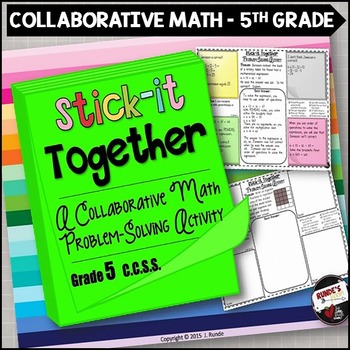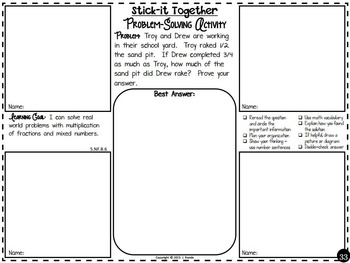Math Word Problems 5th Grade Collaborative Problem Solving Worksheets
- Zip
What educators are saying
Description
This Stick-It-Together math word problem resource is a collaborative problem solving activity for small groups in your classroom that keeps each student accountable for their own thinking, as well as working together to build their best answer together.
Each page contains a different math word problem (one question for each standard in the 5th grade common core standards for math), an “I can …” learning goal, spaces for students’ individual answers on sticky notes, a space for them to collaboratively build their best answer using the individual responses, and success criteria for constructed responses in math.
This activity works best for small group exploration of problem-solving and the understanding of different concepts covered during math lessons. Students will answer the question individually first (on their sticky note), all at the same time, and when all students in the group have completed their answers, they will stick their notes on the sheet. They will then take turns explaining their solutions aloud to the group. Then, working together, they will reflect on the strengths and areas of need in their own answers to take their individual responses and combine the best parts of them to form the best possible answer, making improvements as they construct the answer. As a group, they will evaluate their “best” solution using the applicable success criteria provided on the page to ensure they have included all the criteria needed.
Completed group response sheets could be placed under the document camera and projected so students can present the solution they came up with to the rest of the class. As they do so, they can explain where they included the success criteria in their solution.
Each main section in the Table of Contents is hyperlinked for easy printing or referencing of the pages you require. There is also a rubric for assessment (two rubrics on the page for easier photocopying), and an answer page (as students explanations and strategies may vary depending on the questions and collaboration, a numerical answer is given for each question only). The last page contains a blank template for you to add your own learning goal and problem. Levelled exemplars are also included.
I have revised this file to now include a blank, editable template (in powerpoint). The success criteria checklist is still included on the page, but you can add your own questions and learning goals.
Other Grade Levels in this Series:
***********************************************************************************************************
Follow me on Instagram or Facebook to see more of my classroom ideas!





